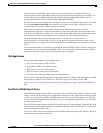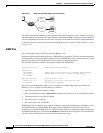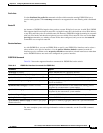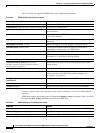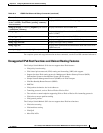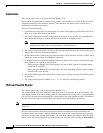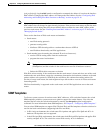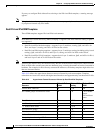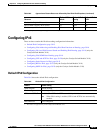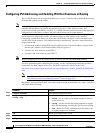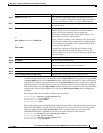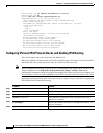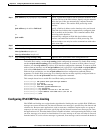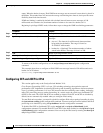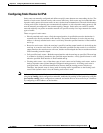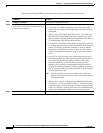
39-15
Cisco Catalyst Switch Module 3110 and 3012 for IBM BladeCenter Software Configuration Guide
OL-12189-01
Chapter 39 Configuring IPv6 Host Functions and Unicast Routing
Configuring IPv6
Configuring IPv6
These sections contain this IPv6 forwarding configuration information:
• Default IPv6 Configuration, page 39-15
• Configuring IPv6 Addressing and Enabling IPv6 Host Functions or Routing, page 39-16
• Configuring IPv4 and IPv6 Protocol Stacks and Enabling IPv6 Routing, page 39-18 (only the
Catalyst Switch Module 3110)
• Configuring IPv6 ICMP Rate Limiting, page 39-19
• Configuring CEF and dCEF for IPv6, page 39-20 (only the Catalyst Switch Module 3110)
• Configuring Static Routes for IPv6, page 39-21
• Configuring RIP for IPv6, page 39-23 (only the Catalyst Switch Module 3110)
• Configuring OSPF for IPv6, page 39-25 (only the Catalyst Switch Module 3110)
Default IPv6 Configuration
Table 39-6 shows the default IPv6 configuration.
IPv4 or MAC QoS ACEs (total) 0.5 K 0.5 K 0.5 K
IPv4 or MAC security ACEs (total) 1 K 0.5 K 1 K
IPv6 security ACEs 1 K 1 K 1 K
1. IPv6 policy-based routing is not supported on the Catalyst Switch Module 3012.
Table 39-5 Approximate Feature Resources Allowed by Dual IPv4-IPv6 Templates (continued)
Resource
IPv4-and-IPv6
Default
IPv4-and-IPv6
Routing
IPv4-and-IPv6
VLAN
Table 39-6 Default IPv6 Configuration
Feature Default Setting
SDM template Default desktop.
IPv6 routing
1
1. This feature is supported only on the Catalyst Switch Module 3110.
Disabled globally and on all interfaces.
CEFv6 or dCEFv6
1
Disabled (IPv4 CEF and dCEF are enabled by default).
Note When IPv6 routing is enabled, CEFv6 and dCEFv6 are automatically
enabled.
IPv6 addresses None configured.



